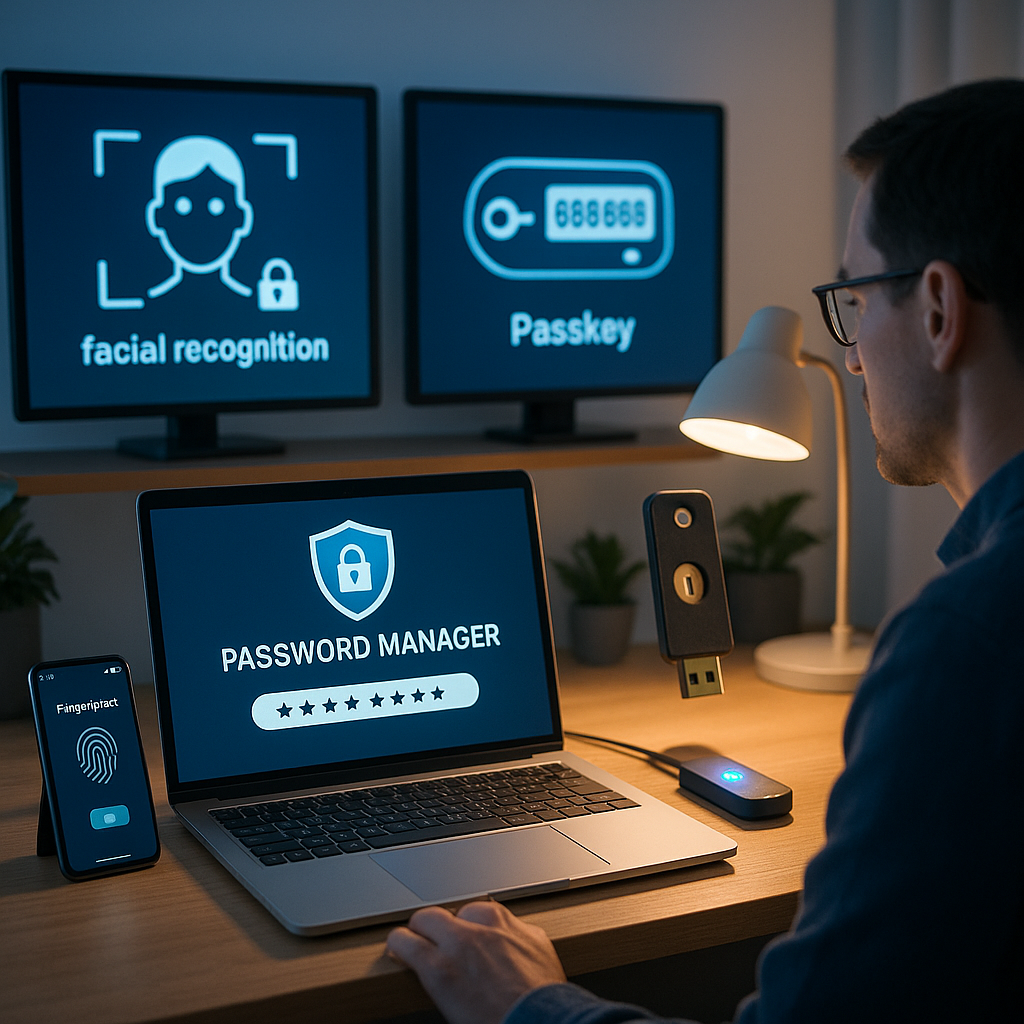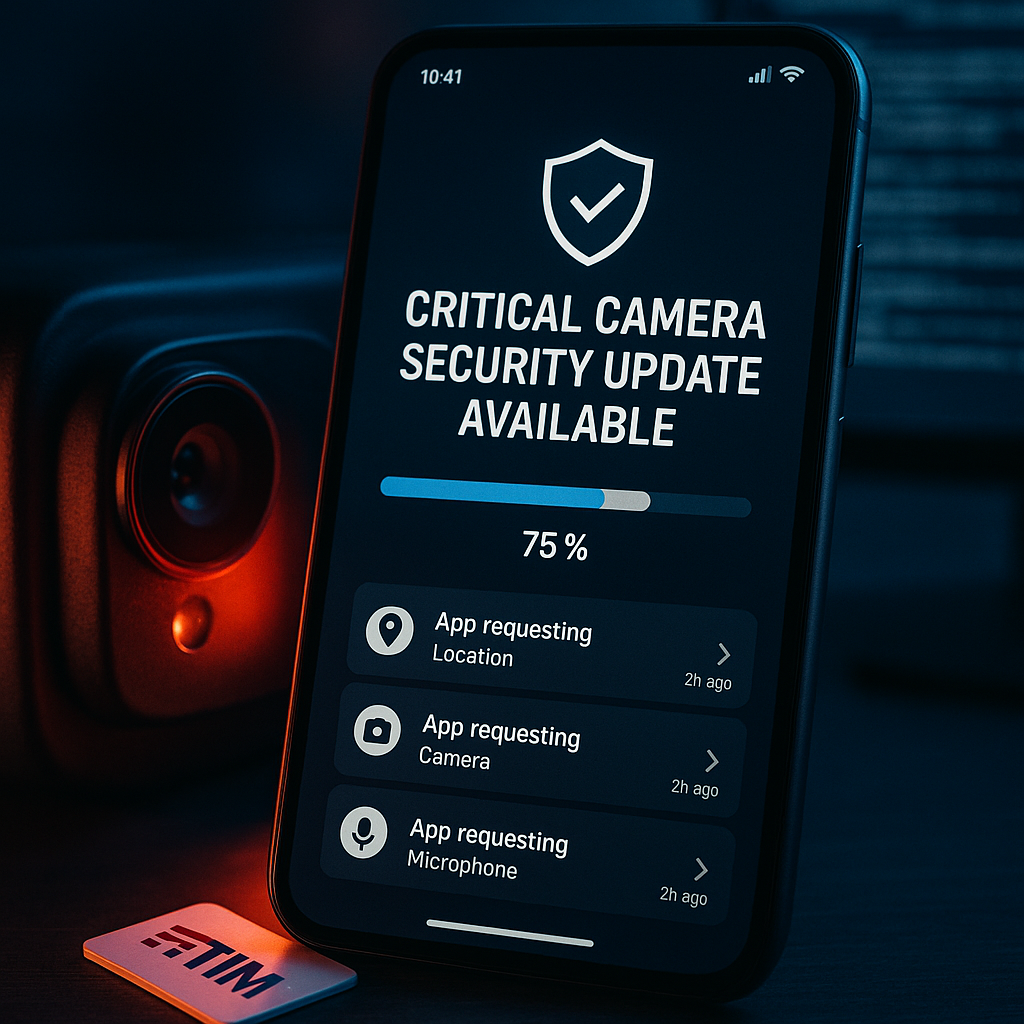Key Takeaways
- Encrypted vaults shield your secrets: Password managers protect your login credentials inside heavily encrypted vaults, making it virtually impossible for hackers to access your data without your master password.
- Zero-knowledge architecture puts you in control: The most advanced solutions use zero-knowledge design. This ensures your encrypted data remains private, with even the password manager itself unable to access your credentials, so only you hold the keys.
- Multi-factor authentication locks out intruders: Today’s password managers employ multi-factor authentication (MFA), combining something you know, have, or are to add powerful layers of protection against unauthorized access.
- Next-gen security: Passkeys revolutionize authentication: Leading password managers now support passkeys, a passwordless, cryptographic system offering quick, phishing-resistant logins and seamless syncing across devices.
- Cross-device synchronization keeps you seamlessly secure: With real-time advanced syncing technology, you can access your password vault from any device, with updates reflected instantly and passwords protected from cloud-based exposure.
- Robust response to breaches protects your accounts: In the event of a breach, encryption and MFA make it nearly impossible for attackers to misuse stolen information. Many services proactively alert you to compromised logins for quick remediation.
- Smarter integrations future-proof your protection: Top password managers for 2025 are extending beyond traditional logins. Integrations with browsers, operating systems, and biometrics ensure they keep pace with new cyber threats and technology environments.
- Not all features are created equal; choose wisely: Comparing the best password managers of 2025 highlights critical differences in free features vs. paid tiers, passkey support, security audit tools, and overall usability. Careful evaluation ensures you choose the manager best matched to your personal or professional needs.
As password managers integrate advanced authentication methods and continually upgrade their security tools, they remain essential for online protection. In the following sections, we explore how they deliver this security, examine leading solutions in 2025, and offer guidance on selecting the right fit for your digital lifestyle.
Introduction
Most data breaches share a common weakness: poorly chosen or reused passwords that offer an easy gateway for cyber attackers. In 2025, password managers are rapidly evolving from simple vaults that store your logins into comprehensive guardians of digital security. By combining features like encrypted vaults, zero-knowledge design, multi-factor authentication, and cutting-edge tools such as passkey integration, these solutions have set a new standard for online protection.
Today, the question is not simply whether password managers are secure, but how well their advanced features address emerging cyber threats and new technology demands. Understanding the latest innovations can help you confidently choose a password manager that will protect you well into the future. Let’s explore what makes the top password managers of 2025 excel, how they secure your online life, and key criteria for selecting a tool you can trust.
Understanding Modern Password Manager Architecture
A solid digital defense starts with a strong foundation. To appreciate why today’s password managers offer unmatched protection, it’s helpful to understand the architecture and security methods that drive them.
Un passo avanti. Sempre.
Unisciti al nostro canale Telegram per ricevere
aggiornamenti mirati, notizie selezionate e contenuti che fanno davvero la differenza.
Zero distrazioni, solo ciò che conta.
 Entra nel Canale
Entra nel Canale
Zero-Knowledge Encryption in 2025
Password managers have seen significant advances, particularly in zero-knowledge architecture (meaning the service provider has no ability to access your data). The backbone of this security is robust AES-256 bit encryption, supported by cutting-edge practices like Argon2-based key derivation functions, which transform your master password into a unique encryption key.
Core technical safeguards include:
- Local-first encryption: Data is encrypted on your device before syncing or upload.
- Salted hashing: Minimum 100,000 iterations protect your master password from brute-force attacks.
- End-to-end encryption: All sync operations between devices are encrypted to prevent interception.
- Encrypted memory spaces: Credentials are only decrypted when needed and are wiped from memory after use.
Industry-leading providers deploy these defenses with impressive results. For example, Bitwarden’s open-source platform passed 12 independent security audits in 2024, demonstrating authentic zero-knowledge operation. Similar processes have been adopted by services like 1Password and Dashlane, catering to both individual and enterprise clients across banking, healthcare, legal, and retail sectors.
For a deeper understanding of encryption in modern security tools, see this breakdown in end-to-end encryption.
Vault Security and Data Protection
Password vaults take a layered approach to security in 2025, combining physical hardware integration with advanced software controls. The outer protective layer uses TPM (Trusted Platform Module) hardware for device-level encryption, while internal encrypted containers ensure each set of credentials has a unique key.
Critical protective layers include:
- Memory-safe programming: Prevents notorious buffer overflow exploits.
- Secure enclaves: On devices supporting biometrics (such as Face ID or fingerprint sensors), credentials are further shielded inside system-level secure processing.
- Real-time breach monitoring: Alerts users if their credentials appear in known data leaks, with automated tools ready to rotate passwords as needed.
- Quantum-resistant encryption preparation: Forward-thinking algorithms anticipate the next wave of cybersecurity challenges.
The impact is clear across industries. Research from CyberSec Analytics found that organizations using password managers saw a 97% reduction in successful credential-based attacks compared to teams relying on manual password management. Similar improvements have been observed in the educational sector, where faculty and students benefit from institutional password manager deployments.
For additional practical steps you can take to keep your accounts secure, review our cyber hygiene checklist.
Advanced Authentication Methods
Refining the ways you access your vault is just as important as securing its contents. Modern authentication methods maximize both security and user experience.
The Evolution of Multi-Factor Authentication (MFA)
Multi-factor authentication has grown far beyond SMS codes. Today’s password managers offer adaptive MFA, dynamically adjusting the level of security required based on context and risk.
Innovative MFA techniques include:
- Behavioral biometrics: Analyze keystroke rhythm, mouse movement, or device handling.
- Location-based authentication: Leverage encrypted GPS data to verify trusted locations.
- Hardware security keys: Use devices certified to the FIDO2 standard for strong, phishing-resistant logins.
- TOTP with blockchain verification: Provide tamper-resistant, time-based one-time passwords.
These adaptive strategies are increasingly adopted across sectors like finance (where transactions require contextual verification), healthcare (safeguarding patient records), and manufacturing (to protect IP and OT systems). Organizations that use adaptive MFA solutions report a 99.9% drop in successful compromise attempts.
If you want to enable or optimize multi-factor authentication on your accounts, our guide to setting up multi-factor authentication covers the essentials for stronger account protection.
Passkeys and Next-Generation Authentication
Passkeys represent a fundamental shift toward a passwordless future. Instead of memorizing or managing dozens of complex passwords, users authenticate with a cryptographic key pair (one public and one private) managed seamlessly by their password manager.
Key advantages of passkey adoption include:
- Phishing immunity: Passkeys are resistant to trickery, as they rely on site-specific cryptographic proofs.
- Effortless synchronization: Passkeys sync securely across devices (including smartphones, tablets, and desktops) without exposing credentials to third parties.
- Biometric integration: Users enjoy instant logins with fingerprint or facial recognition.
- Reduced user burden: No more forgotten passwords or frequent resets; logins become as easy as a fingerprint tap.
This trend is rapidly impacting consumer and enterprise services. By 2025, over three-quarters of major websites, from banking to telemedicine, have adopted passkey authentication, representing a significant advance in digital security across multiple industries.
Un passo avanti. Sempre.
Unisciti al nostro canale Telegram per ricevere
aggiornamenti mirati, notizie selezionate e contenuti che fanno davvero la differenza.
Zero distrazioni, solo ciò che conta.
 Entra nel Canale
Entra nel Canale
To explore why password managers have become essential (and not optional) in the era of advanced authentication, check out why password managers aren’t optional anymore.
Feature Comparison and Selection Criteria
Selecting a password manager that matches your personal or business requirements means looking beyond the basics.
Essential Features for 2025
To remain truly effective, modern password managers should offer these foundational capabilities:
- AI-powered strength analysis: Machine learning tools that identify weak or reused passwords across accounts.
- Dark web monitoring: Continuous scans for your credentials, with automated response actions if leaks are detected.
- Seamless cross-platform sync: Access your vault with offline functionality, ideal for travel or remote work scenarios.
- Secure password sharing: Granular controls for sharing credentials with family, colleagues, or students.
- Emergency access protocols: Designated recovery paths if you’re unable to access your account.
Premium offerings now often extend to:
- Dedicated encrypted storage for sensitive documents (wills, contracts, or medical records)
- VPN services to encrypt internet activity for privacy-conscious users
- Identity theft insurance as an added layer of protection
- Priority support and personalized consultations with cybersecurity experts
For a comprehensive walkthrough on what to look for when assessing these features, see our password manager guide.
Balancing Security and Convenience
Striking the right balance between rigorous security and day-to-day convenience is key. Overly complex requirements can drive risky user behaviors, while convenience features must never undermine the core security of your vault.
High Security, Lower Convenience:
- Requirement for long, complex master passwords
- Mandatory second-factor approvals for all new devices
- Manual reviews of permission changes or credential updates
- Frequent prompts for password updates and strict complexity rules
Better Convenience, Maintained Security:
- Biometric logins (fingerprint or facial recognition) for quick, secure access
- Contextual authentication that adapts to your environment and devices
- Automated, secure form filling for web and app logins
- Smart integrations with home or workplace devices for password autofill
Data from consumer behavior analytics suggests passwordless and adaptive authentication methods increase adoption by 40%, while sustaining or even surpassing traditional security standards. This has driven password manager adoption in diverse fields, from freelancers managing multiple client portals to parents safeguarding family accounts and small businesses upgrading remote workforce security.
With these features and trade-offs in mind, organizations and individuals can implement password management solutions that prioritize both robust security and an intuitive user experience.
Conclusion
Modern password managers have fundamentally redefined digital security by combining advanced encryption, hardware-level protections, and adaptive multi-factor authentication to create a virtually impenetrable shield around user data. With continuous advancements, including quantum-resistant algorithms, biometric MFA, and widespread passkey support, these solutions have far outstripped traditional password practices. They minimize risk from breaches, block phishing attacks, and enable simple, secure access across all devices.
However, leading the digital security game is not just about adding layers of protection. The challenge is to strike the optimal balance between uncompromising security and practical everyday usability. Forward-looking features like AI-driven strength analysis and effortless passwordless workflows are closing this gap, allowing users to fortify their identities without frustration or technical hurdles.
Looking to the future, staying ahead means not just reacting to threats but proactively embracing the technologies that shape safe online experiences. Whether you are an individual, a small business, an educator, or a healthcare professional, adopting a next-generation password manager is no longer just an option. It is a vital step toward lasting digital self-reliance and peace of mind. As the authentication landscape continues to evolve, those ready to act decisively will not only protect their credentials, but also shape a safer, smarter digital world for everyone.





Leave a Reply